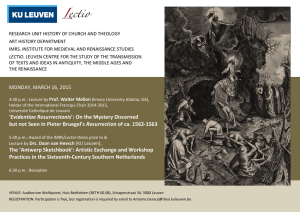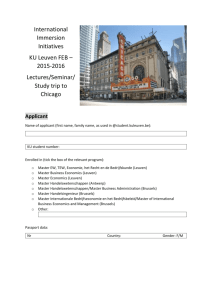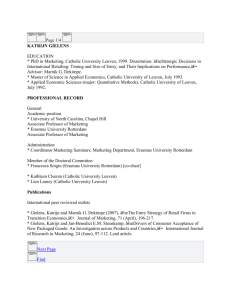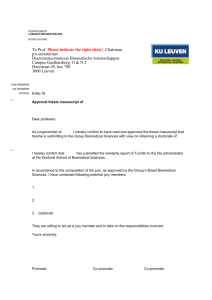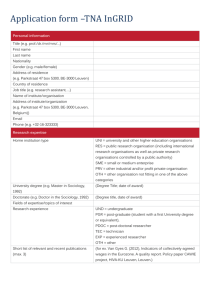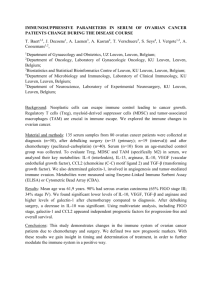Testing and evaluating students - Lirias
advertisement
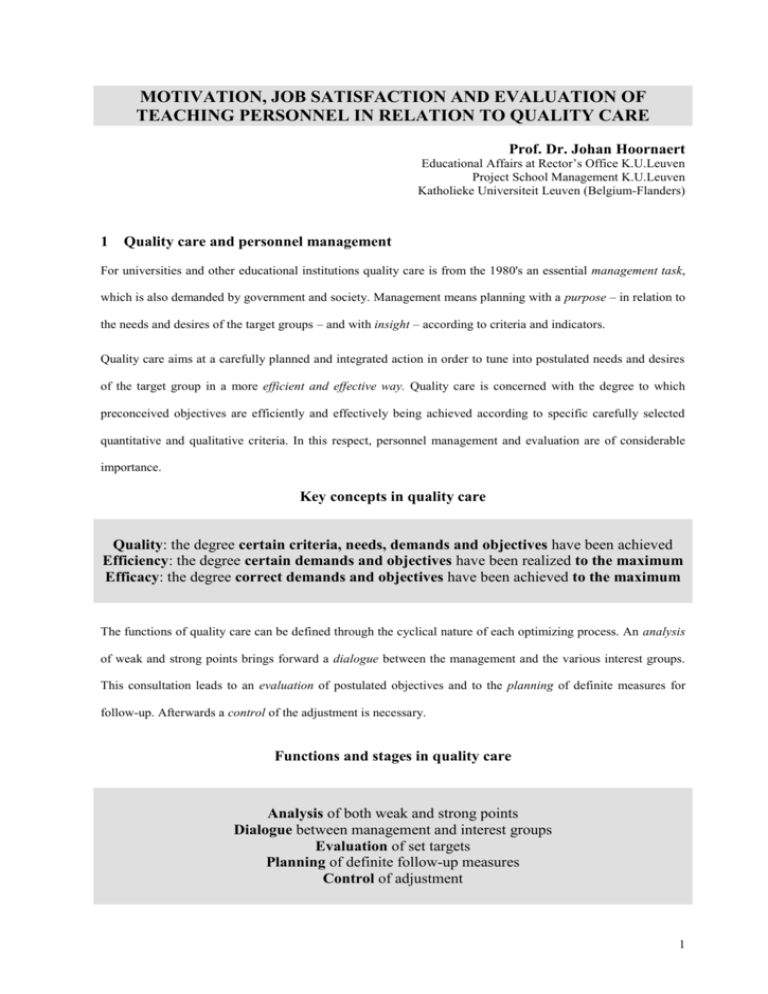
MOTIVATION, JOB SATISFACTION AND EVALUATION OF TEACHING PERSONNEL IN RELATION TO QUALITY CARE Prof. Dr. Johan Hoornaert Educational Affairs at Rector’s Office K.U.Leuven Project School Management K.U.Leuven Katholieke Universiteit Leuven (Belgium-Flanders) 1 Quality care and personnel management For universities and other educational institutions quality care is from the 1980's an essential management task, which is also demanded by government and society. Management means planning with a purpose – in relation to the needs and desires of the target groups – and with insight – according to criteria and indicators. Quality care aims at a carefully planned and integrated action in order to tune into postulated needs and desires of the target group in a more efficient and effective way. Quality care is concerned with the degree to which preconceived objectives are efficiently and effectively being achieved according to specific carefully selected quantitative and qualitative criteria. In this respect, personnel management and evaluation are of considerable importance. Key concepts in quality care Quality: the degree certain criteria, needs, demands and objectives have been achieved Efficiency: the degree certain demands and objectives have been realized to the maximum Efficacy: the degree correct demands and objectives have been achieved to the maximum The functions of quality care can be defined through the cyclical nature of each optimizing process. An analysis of weak and strong points brings forward a dialogue between the management and the various interest groups. This consultation leads to an evaluation of postulated objectives and to the planning of definite measures for follow-up. Afterwards a control of the adjustment is necessary. Functions and stages in quality care Analysis of both weak and strong points Dialogue between management and interest groups Evaluation of set targets Planning of definite follow-up measures Control of adjustment 1 2 Strategic view on quality care In order to achieve organizational quality with efficiency and efficacy it is essential to have a strategic view concerning quality care. This vision has to be supported by all staff members and includes: (1) achieving goals, (2) helping and training personnel and providing an adequate material infrastructure, (3) increasing results, (4) advancing an optimum organizational culture. Personnel management and personnel care are assimilating parts of this vision. 1 Firstly, quality is striven for in the achieving of the correct objectives by offering solid discussions and activities, which enable users and personnel to make efficient and effective use of the time available. Improvements at this level are aimed at, for example, approach, promoting creativity. 2 Secondly, quality can also be improved by paying attention to improvements in the field of personnel: evaluation, training and adjustment, and of infrastructure: rooms, library, information-and communication technology. 3 Thirdly, quality can be achieved by concentrating on the quality of service as a product. For example, one can pay attention to information and help, output and feasibility, social-ethical and philosophical attitudes. 4 Lastly, one can pay attention to the advancement of an optimum organizational culture by emphasizing for example, the strategic mission, discipline and consultation, rest and dynamism, or order and innovation. Strategic views on quality care in educational institutions 1 2 3 4 Achieving the correct objectives for a maximum number of users - concrete objectives - range of activities - sufficient depth and creativity - adequate connection with justified needs Helping personnel and providing infrastructure - financing, personnel framework, task load and -distribution, career planning - working styles, strategies, continued development, self-study, training - function-, functioning- and evaluation discussions, feedback and guidance - infrastructure: buildings, rooms, educational aids Increasing results - information, counseling activities - output, innovation, consultation and cooperation with colleagues - feasibility, creativity, acting independently, guidance - attitude training Enhancing an optimum organizational culture - strategic mission or task and function declaration - discipline, consultation and good agreements - balance between rest and dynamism - order and innovation 2 3 Education institutions are no commercial entities Because educational institutions are different from commercial organizations they have to develop a different management strategy and hence organize their own strategy of quality care of the personnel. This different strategy reveals the bottlenecks for the personnel evaluation. 1 The service offered by educational institutions is not always immediately tangible and measurable. 2 Educational institutions do not seek profit in a traditional sense, but fulfill a social function. 3 The money of educational institutions is largely derived from the government, but nowadays also more and more from third parties, for which they obtain personnel, energy, goods and respect. 4 Service of educational institutions includes non-material costs, which can not be calculated. 5 The organization of educational institutions establishes a relationship with the service clientele, which is not free of any obligations or consequences. This is why the selection of an educational institution is a process of consideration, which does not only involve personnel, but also other parties. 6 The results of the service of educational institutions derive from complex teamwork with the organization, which has many managers. Success depends on the active involvement, expectations, degrees of liberty, capacity, and on the motivation of the personnel as well as the users, who are both clients and active products of the services provided. Besides, a few other partners are responsible for the design and coordination of the program, infrastructure and financing. 7 The result of the services of educational institutions depends on the labor-intensive interaction with the various partners, who usually fulfill their tasks quite autonomously, according to their own vision, qualities and style. The evaluation of the organization by colleagues will often not take place, for example because of wrongly understood academic freedom or out of fear for negative counter-reactions. Hence, quality control of personnel of educational institutions becomes considerably more difficult and often gives rise to resistance. 8 Educational institutions have their own unique culture (norms, values, targets, opinions) and climate, which can not easily be altered. 9 Educational institutions do not take part in the free market, but are limited by laws, rules and structures. 10 The distribution (localization) of educational institutions is limited. 3 4 Central quality care for education at University of Leuven (K.U.Leuven) 1 Mission statement and personnel management Quality is of central importance in the K.U.Leuven’s mission statement. This has an effect at every level and in all the processes of the university. The K.U.Leuven’s mission statement places especially the emphasis on indepth research and transfer of knowledge. For every part of every study program, the K.U.Leuven gives lecturers teaching tasks for a period of five years. Then the lecturer’s performance is assessed for that task. If he has performed well, his tenure is extended for a new period of five years. In the case of poor performance, the university can demand improvements or even replace the lecturer concerned. The faculty assessment commissions, whose job it is to make recommendations to the academic authorities regarding appointments and promotions use a central defined list of criteria for their assessment of the candidate's teaching capacities in addition to the scientific qualifications. Because K.U.Leuven places now equal weight on the teaching and scientific aspects of its staff's work, appointments and promotions were based both on the scientific and educational aspects. An assessment commission is appointed for each department for a period of three years. Each assessment commission has as members: the departmental Chairman – if he is an ordinary professor –, two ordinary professors of the faculty, and two or three ordinary professors of the department. Two or three additional members, ordinary professors of the university or another Belgian or foreign university are appointed by the rector on the recommendation of the dean of the faculty. The Program Director is asked also to give advice. The Dean of the faculty is consulted during the entire preparatory phase of the decisions of the Academic Council. The executive committee of the Academic Council has a threefold task: (1) to investigate of the proposals and recommendations of the assessment commissions, (2) to request the personal recommendations of the dean, (3) to formulate proposals for approval by the Academic Council. If proposals differ significantly from those of the assessment commissions, the Chairman of the assessment commission is contacted for discussion about these differences. The comments of the Chairman are given within one week and added for discussion by the Academic Council. The Academic Council has also to taken into account for decisions the specific policy options and the opportunities for new challenges of the department, the faculty, the university, and the government. For instance, a maximum of 20 % of the legally permitted personnel allocation may be ordinary and extra-ordinary professors. Only one fourth of the demands for promotion can be answered positively. 4 Every three years the teaching staff is evaluated by an evaluation committee taking into account the following portfolio. If the evaluation is negative a new evaluation takes place the next year. After two negative evaluations the member of the staff has to leave the university… Evaluation criteria for the assessment commissions and the portfolio Scientific productivity and value and continuity of publications Articles in international journals with international referees Articles in other scientific journals Communications at international or other congresses Internal reports Books or articles in books Editing of books and journals New products or findings, other than publications Research projects Guidance of doctoral dissertations Scientific grants, prices and distinctions Study visits Organization of congresses and workshops Participation in research committees Teaching tasks and transfer of research in teaching Expertise in study fields other than the own research fields Development of educational forms, study materials and contents and evaluation forms High teaching qualities Teaching and educational management Guidance of students Professional Development Participation in educational committees and management Other services in research and teaching Medical clinical activities International development co-operation Advice and expertise Participation in scientific organizations and committees Tasks in other organizations Participation in spin off companies Participation in application of scientific knowledge Participation in popularization of science Other activities of scientific service 2 Central Academic and Educational Councils The Bureau of the Academic Council (Rector and three Vice-Rectors, General Manager, three Coordinators – for research, education and students –) acts as the executive arm of the Academic Council (Bureau of the Academic Council, thirteen Deans of faculties, three representatives of professors, assistants and students). 5 In addition, an Educational Council (with academics, students, policy and supporting staff as members) advises the previously mentioned bodies for educational matters. All faculties are represented in the Educational Council, which is meant to guarantee good communication between central and the decentralized levels. Monthly meetings are held and task forces are established to cater for special needs. Special initiatives are launched to train educational personnel. For example, a training program for lecturers and teaching assistants has been developed. However, the Educational Council is consensus-bound by the University Council and Faculties, and any decision needs the approval of all concerned bodies and actors. Nothing is decided without a clear consensus. Curriculum and teacher evaluation procedures have been developed at the initiative of the Educational Council as a response to increased pressure from students to start systematic measurement of learning and teaching. A special Research and Development Cell on Innovation in Education collaborates closely with the previous bodies on proposing solutions and identifying needs. Since 1996-1997, the K.U.Leuven has a budget for education-oriented research, development and implementation projects. It finances projects, which fall in priority areas such as ‘supervised self-study’. The projects must also fit in with the university policy on teaching, and its results should be useful for others. 3 Central Educational Services The multiplicity of academic bodies dealing with education is matched by four central educational services. The University Education Service and the Service for Educational Policy provide services to users through targeted programs proposed to departments and faculties. Also, at the initiative of the Educational Council programs aiming at motivating teachers to new pedagogical approaches are developed by the University Education Service. The Service for Educational Policy advises and prepares policy-making documents to be adopted by the Educational Council and co-ordinates campus-wide actions. Additionally, the University Education Service provides pedagogical and didactic support to inter-faculty workgroups and to the educational training courses for lecturers and assistants. A tutoring project is being introduced for new lecturers. The Service for Educational Policy develops also research methodologies in university pedagogy. The unit carries on research, studies and evaluation of pedagogical activities in faculties, departmental curriculum development. The Audio-visual and Net Service develops audio-visual and digital study and teaching materials and is functioning internally as a locomotive in educational approaches within the K.U.Leuven. The context chosen for reaching this primary goal is to foster Information and Communication Technology ICT-based ‘open and distance learning’. This service is conceived as a centrally funded permanent structure. It provides (1) expertise 6 building and exchange, (2) support to faculties, (3) project co-ordination and subsidiary initiatives, and (4) external services. Additionally to external activities, the service subcontracts the management of distant education in a network of European and American higher education institutions and companies. The same role plays the Impulse Center for Educational Innovation at the K.U.Leuven Campus Kortrijk. The Louvain University Department for Information Technology coordinates the hardware aspects for the effective use of Information and Communication Technology (ICT). 4 Student representatives Students are represented at every level: Permanent Educational Commission, evaluation commissions, Faculty Council, Educational Council, Research and Development Cell on Innovation in Education, Academic Council, Board of Management. The contribution of the students in these commissions is very important and of a high quality. The student representatives in the various councils are well organized and can count on financial support from the university, without any intervention in what they do. The views of the students on current matters related to quality assurance in academic education are explicit and well thought. 5 Faculty quality care for education at University of Leuven (K.U.Leuven) 1 Permanent Educational Commissions (POC's) At curriculum level quality assurance is structurally imbedded at K.U.Leuven in Permanent Educational Commissions (POC). Every study program has a POC, chaired by a Program Director and consisting of professors, assistants and students. At least one third of the members of these commissions are students. It is the duty of the POC to guard the curriculum and to permanently oversee the quality of the education. This includes also the discussion about the content of the syllabi. Attention is also given to the measurement of study time, in an attempt to control the overall workload for the students. Finally, it plays a key role in initiatives that are directed at educational innovation. Each year the program directors are invited to a study meeting concerning topics of common interest. Case studies are presented and discussed in group. The Education Council profiles the conclusions of the discussions in recommendations for decision by the Academic Council. 7 2 Internal and external quality assurance systems From 1993-1994 external legislation and internal pressure from students resulted in an attempt to systematize evaluation efforts. Quality assurance by the government consists of examining the internal and external quality assurance systems. External quality control is organized every eight years. This inspection system is set up in collaboration with the other Flemish universities (Flemish Inter-university Council: VLIR) and other higher education institutions (Flemish Higher Education Institutions Council: VLHORA) and the Dutch-Flemish Accreditation Organization: NVAO. This visitation system is based on a peer review system (five experts from other universities and one student visit each study program during several days) that follows on from prior self-evaluation by the discipline. Internal quality assurance is programmed for each curriculum every four years. This process takes two years: one year of self-evaluation and one year of general and individual follow-up. The general report delivers the material for the self-evaluation report in preparation of the external visitation or as an internal follow-up evaluation after the external evaluation. The individual reports define the results for each course component and person concerned. One year after publication of the visitation report of the inspection team the POC has to submit a follow-up report to the Academic Council of the university after intensive screening in detail by the central committee. In this report must be explained in detail the changes that have been introduced. During that year a discussion takes place between the people involved in the study program and the members of the Education Council. The main purpose of these discussions is to support the study program to devise the most adequate follow-up. There is also a periodical evaluation of the individual courses every two years by two tracks. Evaluations directed at quality improvement aim at giving teachers feedback on their teaching and at supporting them in optimizing their teaching. These evaluations are organized by the POC in agreement with the dean. The results are not included in the record of the individual teachers. This gives the POC and the instructors the chance to work on teaching in a safe environment and to experiment with evaluation procedures and teaching techniques. Evaluations directed to quality control follow a different logic. For this evaluation students are questioned at least every four years on the basis of closed questionnaires with free commentary space. The evaluation end up automatically in the teaching file one year later, after the teacher has had the opportunity to comment and to eventually remediate weak points. Finally, at the level of individual courses and lectures, individual efforts are delivered to optimize quality. Spontaneously and increasingly after a negative evaluation, lecturers can decide to take part in a detailed 8 evaluation of their teaching behavior. Some standardized evaluation instruments are available to examine various aspects. This includes questionnaires which lecturers can ask students to complete in order to ascertain the strengths and weaknesses of their teaching behavior or of the written course and the support material. 3 Principles of the internal and external quality assurance system 1 The faculty is responsible for preparation, data collection and processing, reporting and follow-up. The faculty composes in consultation with the chairman of the permanent education commission and the student representatives an evaluation commission. 2 All the categories concerned participate in this evaluation: teaching staff, students, alumni, and people from the professional field. An expert of the central university education service advises the commission. The collaboration of the students and the expert is very effective. 3 The evaluation of educational quality requires the formulation of assessment criteria for the various aspects of university education. This frame of reference for high quality education sets out the objective of a course and the conditions to achieve the objectives. 4 The educational evaluation contains a quality assessment on the overall program (curriculum, student results, teaching facilities and infrastructure) and the quality control of the evaluation of the individual course components (content, teaching, materials, testing, study and teaching time). 5 Various methods and tools are used to gain insight into both the program and individual course components: closed or open questionnaires, interview, document analysis, observation. The choice depends on the size of the group, the objectives being pursued and the results of previous evaluations. 6 Internal and external quality assurance systems are harmonized and integrated by developing a system of permanent quality assurance in which the rules on external quality monitoring are incorporated. An electronic handbook with concrete models is composed by a central working group for both internal and external quality assurance procedures and is evaluated very positively. 7 Follow-up plans are made after each evaluation and ensure the development of a permanent system of educational quality enhancement. General reports describe and interpret the current situation based on the educational frame of reference and outline the consequences for the course as a whole and for the various course components. The general report includes a follow-up plan for improvement and is further discussed by the Permanent Educational Commission, which can accept, reject or amend it. 9 Individual reports set out the evaluation commission’s interpretation of specific results for each course component and person concerned. Each staff member is asked to give his written answer to the interpretations of the commission. After a conversation between the chairman of the evaluation commission and the individual teacher a concrete plan of remedial action is defined, but not used as a sanction. Sometimes suggestions are given for educational training, further analysis or an individual mentoring by a more experienced teacher. In extraordinary cases a conversation with the dean of the faculty is recommended. After one year the results of and comments on educational evaluation intended to control educational quality are taken into account for promotion. 6 Formative evaluation of personnel An analysis of weak and strong points of an organization is often based on an evaluation of the execution of tasks. Etymologically, the word ‘evaluate’ derives from the Latin ‘valere’, which means ‘to estimate the value’. This estimation of the value of an organization consists of the evaluation of objectives, environment and personnel. Given the idea of improvement, which means ‘to make better’, this also includes feedback and adjustment. As such, organizations and personnel do not only receive suggestions about the adjustment of what is wrong or not satisfactory, but also encouragement and affirmation of what is optimal and satisfactory. Besides, a finely tuned evaluation of personnel includes several aspects. Aspects of personnel evaluation in educational institutions 1 2 3 4 5 6 7 8 9 10 Organizational skills: well-arranged, orderly, decisive capacities, flexibility Targets: usefulness, relation to other targets, feasibility, desirability, work load Quality: subject knowledge, preparation, self-creativity and -activity, problem solving Motivation: fascinating, use of methods and means, applications, activating students Difficulty: clearness, structure, explanation, tempo, time management, prerequisites Depth: relevancy, distinction between main and minor aspects, stimulating self study Interaction: letting questions and opinions be heard, solving problems together Information: accessibility, feedback about mistakes and wrong interpretations, guidance Evaluation: transparency, reasonability, honesty, representative, care of own feedback Co-operation: with colleagues, organizational alertness, relation to management 7 Possibility of own comments and follow-up In personnel evaluation, it is essential that the people involved should have the possibility to reflect and comment the evaluation themselves, both before and after. They should also give an overview of their activities themselves. It is especially important that they should have a chance for improvement under professional guidance and that the results of a new evaluation are added to their files. Most often, personnel to whom 10 problems have been pointed out will still have a positive attitude, especially if there are still good opportunities for promotion. An evaluation commission judges all aspects. The personnel file (portfolio) consists of a representation of the actual task as well as quantitative and qualitative data. Besides, it also takes the following into account: the quality of the guiding materials that have been used, the results of the evaluations made by others or third parties (colleagues) and the special efforts to follow training or continued education. 8 Evaluation discussions for personnel Well-being, satisfaction, motivation, ability, task load and continued development are important points of attention for the personnel management. In addition to what school managers are already doing about personnel management, it is good to have someone to discuss one’s own functioning at fixed points in time. In order to counter resistance, a clear agreement about the following aspects is necessary. 1) Measuring scale: preferably a 4 (or 5) point scale, but not everything can be measured: 5 excellent +++ AAA 4 (good or) excellent ++ AA 3 (requiring remedy or) satisfactory (? or) + (B or) A 2 requiring remedy ? (BB or) B 1 does not meet expectation C N not applicable N N 2) Criteria: preferably not too many, maximum 7 to 10 fixed or flexible criteria: education administration and organization technical and logistical organization research provision of services: internal (guidance) and external knowledge, ability and skills (languages, computer) attitudes towards: - institution: training, program, department, faculty, service - function: tasks, involvement and availability - team: initiative, independence, co-operation - communication: behavior towards others, meetings - management: guidance or behavior 3) Expectations: agreed upon targets and bonuses 4) Extra-activities: decided upon in consultation and following the staff’s desires 5) Circumstances and difficulties at work and at home Tasks vary according to their complexity and responsibility (beginners – seniors): 1) executing: implementing tasks without taking risks 2) supporting: co-operating, informing, deciding while bearing small risks 3) organizing: taking action with consequences for training or helping colleagues 4) managing: taking action with consequences for the entire school, guiding colleagues. The emphasis is on encouragement and future-oriented estimation of one’s value and feedback. It is justified to value in a positive way for a maximum number of personnel members. 11 8 Three types of discussions with personnel In function discussions one reaches an agreement about objectives, tasks, evaluation criteria and prior conditions for an agreed upon future period. Functioning discussions are held at intervals; they are concerned with the state of affairs, bottlenecks, advancements and adjustments. In the case of evaluation discussions, one evaluates to which degree arranged tasks have been achieved at the end of the agreed upon period, taking postulated criteria into account. 1 Function discussions The aim is to consult mutually about the tasks as defined in function- and task descriptions or profiles, about the evaluation criteria and prior conditions. Not only tasks and expectations of the supervisors, but also the staff’s preferences, ambitions and desires (personal goals and extra-tasks) are being made explicit with a lot of individual differences. 2 Functioning discussions Functioning discussions take place at a previously planned point in time and according to a clear agreement about the procedure: preparation, themes, notes, confidentiality, evaluation, and agreements. The emphasis is on mutual consult (with equal contribution) about the execution of tasks and the relation with the management. Freedom of any obligation is avoided. The evaluation of the functioning is based on a limited number of previously communicated criteria, concrete expectations and agenda (set targets). It is better to work on a small scale according to a specific (and limiting) motto or central theme, for instance, cooperation in the school, task distribution, extraactivities, continued development, responsibilities, job satisfaction. Attention is paid to prominent, especially positive performances and experiences (and to areas for special attention). This is based on information from primary (individual), sometimes also from secondary (direct superiors, colleagues) and tertiary sources. It is the intention to exchange experiences and perceptions and to come to feasible agreements about adjustments. 12 3 Evaluation discussions The evaluation is done by the manager and at least one assessor, after the advice of other directly involved people, and preferably also by the staff member him/herself. This takes place during a previously fixed time, for example 40 to 50 minutes: 10 minutes of introduction, 10 minutes about knowledge, skills, continued education, 10 minutes about future expectations and agreements, 10 minutes for defining the assessment of points which have been agreed upon, but it is also possible that one reaches an agreement after one week. Only the tasks that have been executed during a previously fixed period are taken into account. Former assessments and discussions should not influence the evaluation. One should pay special attention to the preparation of the people involved. These should be informed about the method, agreements (set targets), fixed criteria (which can nevertheless be altered at regular intervals) of knowledge, ability and attitudes (quality of actual behavior and performance are more important than measurable quantity and personal characteristics), the target scores on the total promotion and career perspectives, adjustments (maximum 1, 2 or 3 themes) or sanctions. The assessor thoroughly prepares him/herself for the likely defensive reactions of the staff member to possibly less positive aspects of the assessment. After participation and agreement of the staff member, the evaluation is brought to an end with the possibility of objections. A negative evaluation is only defined after all means to motivation and guidance have been exhausted. One should offer chances of assessment at intervals. 9 Job satisfaction of the personnel A function-, functioning- and evaluation discussion can easily start with an individual analysis of job satisfaction by the staff member him/herself. In comparison with the managers’ perception of job satisfaction, this analysis will bring about interesting data. It will also often unveil the shortcomings of the management, the study program and the degree, the department, school or service. When brought together, these data hence result in a synthesis of strengths, areas for special attention and of the opportunities and threats of the study program, the degree, the department, school or service. They may form the base and the challenge for action plans with respect to the management. 13 Assessment of job satisfaction Assess the job satisfaction on a scale of 4: from 1 = minimum to 4 = maximum Infrastructure: space, technical aids, information- and communication technology Information transfer: from top to bottom and vice versa, and mutually between colleagues Tasks: education, research, service, working objectives, extra tasks, space of playground Teamwork and meetings: consultation, autonomy, optimizing, follow-up Tackling problems: openness towards management, agreements, follow-up Professional climate: team-spirit, support, willingness to listen, contact with colleagues Professional development: objectives, appreciation, continued development, self-study Personal circumstances and perspectives: preferences, desires, hindrances, shortcomings Relations with others: users of education, other people involved suppliers, competitors Analysis of Strong and Weak points, Opportunities and Threats: SWOT Strong points: I and the others Weak points: I and the others Opportunities and possibilities Threats and improvements 14 10 Follow-up after the personnel evaluation The main goal of personnel evaluation is to improve the quality of the organization and the various activities. In this respect, the follow-up plans are an important instrument. The evaluation commissions are not only responsible for the execution of the evaluation, but also for the follow-up of the improvements. If shortcomings are observed, there is oral consultation between the evaluation commission, the people directly responsible and the staff member involved about the definition of concrete actions that aim at improvement of shortcomings. These actions are being defined in global or individual follow-up plans. Evaluation may give rise to changes in activities or tasks, through e.g. shift in activities, doing more essential activities, increasing the cohesion or furthering the assimilation of several activities. Care for personnel imply an increase of well being, job satisfaction and motivation, as well as the mastery of task load. This is why a less positive evaluation should rather concentrate on the follow-up of the improvement of the personnel than on sanctions. One of the possibilities is personal guidance or improvement advice by a collaborator of the educational guidance service or a colleague. As such, a staff member of the educational guidance center could ask for a more elaborated evaluation with oriented relevant feedback. This quickly enables the person involved to learn which aspects of his behavior are liable to improvement. In consultation with a professional, the detailed evaluation can be translated into an adapted strategy: self-study continued development or individual coaching by a mentor or a tutor. In the case of a clearly noticeable neglect of tasks, the discussions are more difficult. Neglect of tasks means the lack of willingness to improve or the conscious negation of the task. It is important that these discussions should include related positioning and positive feedback about the whole of tasks and the distinct aspects. A continued neglect may result in certain limiting or disciplinary measures. The information given to staff members may certainly affect professional development. However, not all kinds of information or feedback are equally helpful. The degree to which the personnel is likely to appreciate and use feedback in order to do something constructively, depends on the person who gives feedback and especially on the topic and method. The range of strategic interventions in personnel management is considerably wide. 15 Strategic actions for an optimal personnel management Defining targets, tasks, responsibilities and criteria more clearly: task declaration, consultation, function-, functioning- and evaluation discussions Providing more opportunities for personal development: delegating, self-organization, career guidance, self-study, continued development Decreasing the workload: redistribution of tasks, personnel extension, better work planning, priorities Improving relations: teamwork, coaching, positive feedback, agreements, informal contacts Offering rewards: increasing working aids, working space, budgets, responsibility, power; or extending contracts, higher salary, bonus, status, promotion, appreciation, holiday arrangements, timetable, career opportunities, continued development Increasing the capacity: personal development, relational skills, self-management, rational thinking, recognizing stress signals, good relaxation exercises Individual guidance by a professional in education or a tutor Importance of the personnel port-folio for recruitment, appointment or promotion Conclusions Personnel evaluation has to be prepared and executed carefully. Radical changes have little chance of effective realization. Besides there remains a tension between the striving for improvement or remedy on the one hand and the execution of control and sanctions on the other hand. Indeed, sometimes there remains an island structure in which people try not to hamper one another. There also remains a certain amount of resistance against any type of personnel evaluation. Finally, in any personnel evaluation and contents-related task interpretation there should be an optimal equilibrium between essential tasks of the personnel and their individual preferences and desires. All these interventions are oriented to increase motivation and job satisfaction of academic personnel and the educational quality. 16 References Bologna Working Group on Qualifications Frameworks. 2004. A Framework for Qualifications of the European Higher Education Area. Brussels: Education and Culture, Ministry of Science, Technology and Innovation. Commission of the European Communities. 2005. Towards a European Qualifications Framework for Lifelong Learning. Brussels: SEC. Dochy, Filip, Seghers, Mien & Wijnen, Wynand. 1990. Management Information and Performance Indicators in Higher Education: an International Issue. Assen/Maastricht: Van Gorcum. ENQA. European Network for Quality Assurance in Higher Education. http://www.enqa.net. Farnham, David. 1999. Managing Academic Staff in Changing University Systems. International Trends and Comparisons. Buckingham: SRHE and Open University Press. Hofstede, Geert & Hofstede Gert Jan. 2004. Cultures and Organizations: Software of the Mind. New York: Mc Graw Hill. Hoornaert, Johan. 1997. Strategische communicatie voor onderwijsinstellingen: kwaliteitszorg en externe relaties. Leuven: Project Schoolmanagement K.U.Leuven. Hoornaert, Johan. 1998. “Onderwijskwaliteitszorg en personeelsevaluatie. Evenwichtsoefening rond onderwijs, onderzoek en dienstverlening.” Tijdschrift voor Hoger Onderwijs & Management, 4: 51-55. Hoornaert, Johan. 2000. “Role of Students in Educational Quality Assurance at Katholieke Universiteit Leuven (Belgium).” In: University and its Students. International Symposium of Students and Professors, S. Daum, & T. Kruta. Prague: The Karolinum Press, 170-174. Hoornaert, Johan. 2002-2003. “Onderwijsvisitaties aan de Vlaamse universiteiten: ervaringen en evaluatie van de eerste ronde: 1991-2002.” Tijdschrift voor Onderwijsrecht en Onderwijsbeleid, 1: 45-52. Hoornaert, Johan. 2005. “Learn to Learn: Motivation and Evaluation of Students.” In: Educational Systems in Asia and West Europe: A Comparative Approach: Second International Academic Workshop: Curriculum Development and Teacher Education, Zhang Hui. Liaoning: Liaoning University Press. Hoornaert, Johan & Oosterlinck, André. 2005. “Universities from the Perspective of Internationalization.” International Journal for Educational Law and Policy, 1: 244-257. 17 Inspectorate of Education in the Netherlands. 2005. Accreditation in International Perspective. Den Haag: Inspectie van het Onderwijs. Lap, Jan & Verest Bart. 1994. Functionerings- en beoordelingsgesprekken in het onderwijs. Investeren in medewerkers. ’s-Hertogenbosch: KPC. Mertens, Frans J.H, e.a. 1998. Quality in the Flemish Universities. Report of the Audit Commission on Quality Assurance in Academic Education in Flanders. Brussels. Ministerie van de Vlaamse Gemeenschap, Departement Onderwijs, Administratie Hoger Onderwijs en Wetenschappelijk Onderzoek. Neave, Guy. 1989. Paths to Glory: Selection and Recruitment to Academia in the United Kingdom. Paris: International Association of Universities. NVAO: Nederlands-Vlaamse Accreditatieorganisatie (Dutch-Flemish Accreditation Organization). Den Haag: http://www.nvao.be/. Oosterlinck, André. 2002. Trade in Educational Services: A European Perspective. Washington: OECD-CERI. Oosterlinck, André. 2002. European and American Higher Education. Genève: European University Association QANU. Quality Assurance Netherlands Universities. 2004-2005. Gids voor de externe kwaliteitsbeoordeling van wetenschappelijke bachelor- en masteropleidingen ten behoeve van accreditatie. Utrecht: http://www.qanu.nl/. Reichert, Sybille & Tauch, Christian. 2005. Trends IV (Draft report). Brussels: European University Association. Tavernier, Karel. 1991. “Strategic Evaluation in University Management.” Higher Education Management, 3: 257-268. Tavernier, Karel. 1995. “Beleidsvisies en strategisch management in de universiteit.” In: Liber Amicorum Robert Stouthuysen. Leuven: Leuven University Press. Van Avermaet, Eddy. 2002. “Kwaliteitszorg: een knecht met veel meesters.” – In: Tableaux Vivants. Opstellen over taal-en-onderwijs aangeboden aan Mark Debrock. J. Binon, P. Desmet, J. Elen, P. Mertens & L. Sercu. Leuven, Universitaire Pers Leuven: 473-485. Van Damme, Dirk. 2002. Trends and Models in International Quality Assurance and Accreditation in Higher Education in Relation to trade in Education Services. Brussels: VLIR. VLIR: Vlaamse Interuniversitaire Raad (Flemish Inter-university Council). Kwaliteitszorg onderwijs en Accreditatie. Brussel: http://www.vlir.be/. 18
